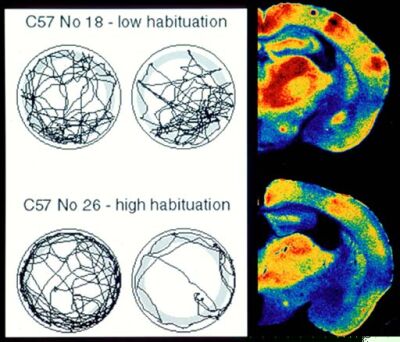
Regional cerebral 2-deoxyglucose uptake during open-field exposure in mice:
metabolic patterns of habituation and exploratory activity
F. Magara1, E. Welker1, D.P. Wolfer2 and H.-P. Lipp2
1IBCM, University of Lausanne, Lausanne, Switzerland
2Anatomy, University of Zürich, Zürich, Switzerland
Analysis of open-field behavior is widely used to assess spontaneous activity and emotionality in rats and mice. Some studies have suggested a differential involvement of right and left cerebral hemispheres in the modulation of this behavior, as well as in other paradigms of emotionally motivated behavior. Accordingly, we have previously reported a higher metabolic activation of the right cerebral cortex in two strains of mice after exposure to an open-field. However, little is known about the relative contribution of the different neural circuits to such a complex behavioral output.
In the present study, we analysed the individual correlations between the regional cerebral uptake of 2-deoxyglucose (2DGU) and open-field behavior in a sample of C57BL/6 male mice (n = 10) and in hybrid C6xI/LnJ mice with callosal agenesis (n = 9). Because absence of the corpus callosum is expected to boost functional hemispheric asymmetries, we also analysed correlations between 2DGU asymmetries and open-field behavior. Mice were injected with a solution of [14C]-2-deoxy-D-glucose, and immediately released into the middle of a large (150 cm x 80 cm), previously unexplored, dimly illuminated (6 lux) arena. The locomotor path of each mouse was recorded for 45 min and then analysed in six blocks, each lasting 7.5 min.
Off-line analysis of the paths was done by means of WINTRACK™, by extracting the following variables: path length, wall distance and habituation. This last parameter was calculated as the difference in path length between the beginning (min 0-7.5) and the end (min 37.5-45) of the open-field session. Thereafter, the mice were withdrawn from the arena, immediately killed by cervical dislocation, and their brains processed using autoradiography. Relative 2DGU was measured in eight cortical fields and six forebrain regions. Correlations between 2DGU rates and behavioral variables were assessed with a parametric test (Fisher's r) and confirmed by a non-parametric procedure (Spearman's rank).
A highly significant negative correlation was found between habituation and the bilateral 2DGU in the lateral nuclei of the amygdala (r = -0.73, p < 0.001): higher 2DGU was associated with more sustained activity throughout the 45-min session, irrespective of the total locomotor activity. This correlation was confirmed when the two groups were considered separately, suggesting that this observation did not depend on strain differences. The lateralized 2DGU in the cerebral cortex was found to correlate with the average distance the mice kept from the walls (Figure 1). More activity in the center of the field was associated with higher 2DGU in the right perirhinal, cingulate, parietal, frontal and infrarhinal cortex (0.63 > r > 0.51, 0.003 < p < 0.023). The correlations between cortical asymmetries and activity in the center of the field were mostly due to the large behavioral variability of the acallosal mice.

Figure 1. Locomotor tracks and corresponding 2DGU of two mice.
These data indicate that the lateral amygdaloid complex is involved in the modulation of locomotor activity in an open-field, and suggest a preferential activation of the right hemisphere during exploration of a novel environment.
Paper presented at Measuring Behavior 2002 , 4th International Conference on Methods and Techniques in Behavioral Research, 27-30 August 2002, Amsterdam, The Netherlands